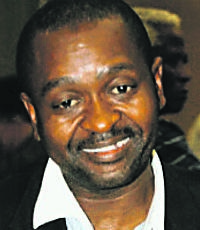
This politically astute student body was founded on true ideals of freedom and dignity, writes Andile M-Africa
This past weekend, the 50th anniversary of the establishment of the SA Students’ Organisation (Saso) was commemorated.
It was a solemn occasion, marked by the reunion of the founders of the black consciousness movement. They gathered at the centre named after Steve Biko in Ginsberg, Eastern Cape.
While seated among the founders, I realised that history offers us periods to pause and ponder – and that history also offers us the option to not do anything, even as our conscience speaks to us.
Non-somethings like myself who were gathered there, who only belong to the mad, second generation of black consciousness, were able to see that Biko does not reside on the sidelines of his fellow founders’ consciousness.
He is blended with their imaginations; he is intimately tied to them.
Despite their having started this journey with Biko 50 years ago, he remains a permanent revelation in each of their lives, an “eternal mystery of being”.
Perhaps the founders of black consciousness truly defined “the age of philosophers”, as Bishop Manas Buthelezi once noted – philosophers who were doing the impossible while enjoying life.
The serious and not-so-serious attitudes that we saw during the years of Saso and the Black People’s Convention were repeated last weekend.
Sessions that were insightful always ended with a night of hard partying, from Friday to Sunday – and for me, this strand of their collective psychology is memorable.
Fittingly, the 50th anniversary programme was slanted towards honouring the memory of Biko’s colleague, Mapetla Mohapi, who was killed in detention in 1976 while Biko was still alive.
This decision reflects a truth that is often overlooked: Biko could not have reached the heights that he did had he been on his own. Biko succeeded because he was part of a collective.
In life and in death, Biko is eternal – because his life and life story have always been in the hands of others.
He is, in other words, imperishable because of this relationship with others.
BLACK CONSCIOUSNESS
Any interpretation that cuts Biko off from his generation and that fails to identify the connecting cord with other creators of the black consciousness ideology, is flawed, misleading and pathetic.
Pathetic, because it seeks to inscribe Biko’s name on some dead museum wall, hoping to garner a reputation in memorialising the man.
Yet, with or without majestic monuments, it is we human beings who are always the ones to breathe life into those we love.
Included on the list of luminaries honoured last weekend were the great struggle couple, Mlungisi and Nonyamezelo Mxenge.
Lawyers of the people, they fought to face the enemy. Like Biko, they are buried in King William’s Town.
The reunion served as testament to that fact that Saso’s founding ideas were a collective work in progress.
Interestingly, these ideas were propelled by a faith in the pioneering spirit – in those who were experimenting and seeking to harness the newness and wonder of their creative minds and sensibilities.
This is a trait typical of young people.
These youths were distinct as dreamers who understood their inherent dignity and power to create.
During those years, black students were into self-creation. They were fully aware of their potential and of the resources at their disposal.
They needed to use both in order to demonstrate to themselves and their kind that they exist and that it is possible to reimagine one’s position.
The story of separate student accommodation in Grahamstown was revisited at the reunion.
This incident heralded a historic occasion, which served to illuminate the consciousness and ruffle “the dull obviousness of daily happenings” in the students’ minds.
The incident was a serious injury to black emotion and standing. It was an incisive wound that offered students deep insight into the situation.
For them, it represented something infinitely more profound and sophisticated than the fact of being deprived of a place directly in the floodlights of Grahamstown.
It represented the rejection of blacks by whites, a real-life experience for the students.
In such a situation, blackness was the focal point. With blackness being undeniable and a huge part of one’s personhood, the students had to realise the value and the reality of their being.
They had to affirm their blackness because the consciousness of the real within them had been brought in touch with the reality on the outside.
What the students did not realise was that the joy of being black would mean nothing to those who did not share the black experience.
Hence, they were on the offensive when it came to impressing on others the fact of their blackness.
Biko, who championed this view, was the first to realise the futility of seeking to convince and convert others. He henceforth emphasised that they should instead speak directly to the people.
The journey to establish and build Saso was bound to happen. The black psyche was no longer prepared to deaden itself.
It needed to enlarge itself by occupying its rightful place in pursuit of the national struggle.
In other words, the founding of Saso was not caused by the “withdrawal” from the National Union of SA Students. Instead, Saso was occasioned by the discussions and debates of 1968.
At that stage, harmony between the students’ inner nature and their outer environment had been created.
Last weekend, a session on theology – given jointly by Professor Barney Pityana, Bishop Malusi Mpumlwana and the chairperson of the Steve Biko Foundation, Ishmael Mkhabela – added clarity to the depth of the students’ spirituality.
It was affirmed that for all the scientific knowledge underpinning our world, it cannot undermine the spiritual comprehension of the soul – a dimension responsible for harmony between the outside and the inside.
Saso represents a laudable vocation. If some in the liberation movement had doubts about Saso – and, in essence, about black consciousness – their suspicion was unnecessary.
All they had to do was open their eyes to the true ideals of freedom, as espoused by the earlier generations of struggle heroes and heroines, and ask whether these were adhered to by the black consciousness approach.
My submission is that the true ideals of freedom were lifted to a higher level by the black consciousness movement.
M-Afrika is a writer and a research fellow based at the University of Fort Hare




 Publications
Publications
 Partners
Partners









